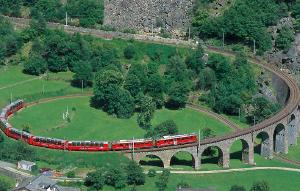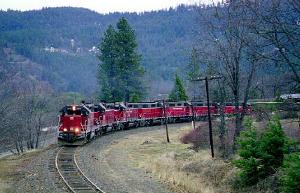The Siskiyou line: Grades and speed
For heavyweight coaches and 1920s steam, the grade of the Siskiyou pass was a major obstacle. If the technology of today is applied, the grade is quite moderate, though. The Siskiyou pass is less steep than some new highspeed track. Several railroads operate trains in friction mode on grades like 7 or 8%.

Brusio, Switzerland: About 10000 passenger trains and 120000 tons of freight per year pass this 7% grade.
Of course, a Shasta route train needs the same power-to-weight ratio as successful passenger train operations on similarely steep and curvy track. Suitable trains have been defined within this article, and can use a line speed of 47 mph with the curvature of the Siskiyou pass. If there is need for this, they can accelerate to this linespeed within the grade, though slowly.

7 engines pull a freight train up the northern side of the Siskiyou pass, a 3.4% grade.
Nonetheless, a limitation has to be considered. There is one freight train per direction per workday. Standard consist: 7 locos, 30 cars. The locos add up to enough traction mass for moving the train, but are old and use a low-power motor. Therefore, the trains operate very slowly on the grade. Without a change of loco type, and increased power, superelevation on the steepest part of the route has to be low, reducing line speed for passenger trains to 40 mph, instead of 47. This problem exists for milepost 404 to milepost 425.